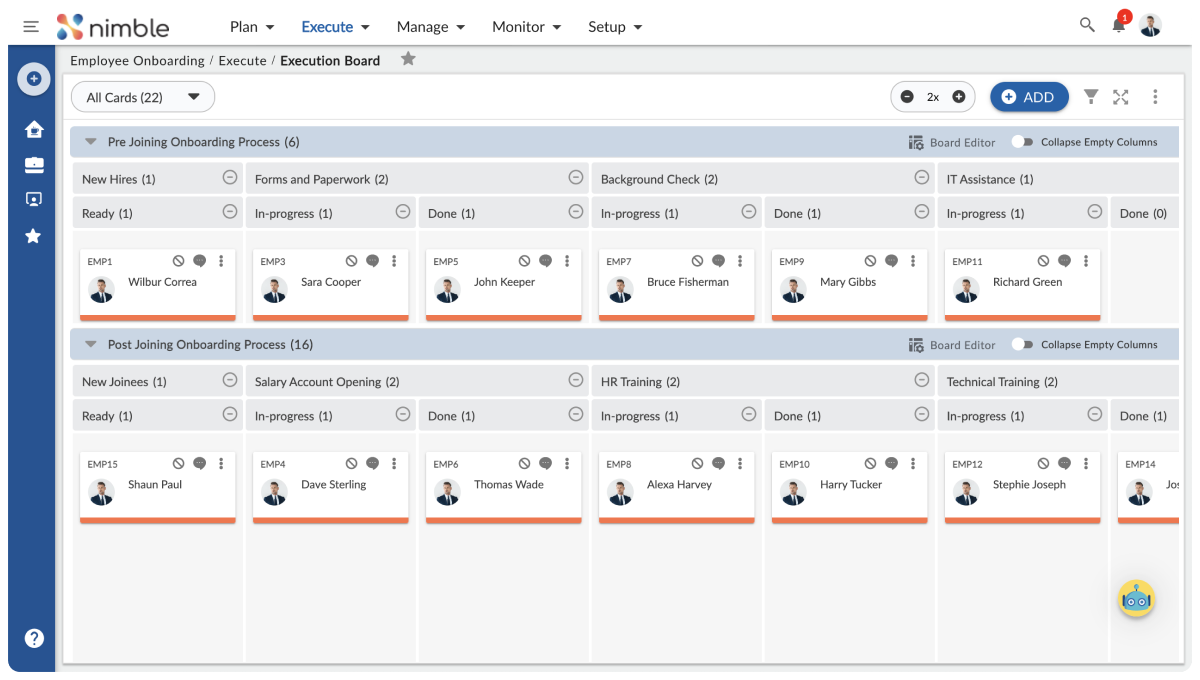Creating an effective onboarding process is crucial for introducing new team members to your organization and ensuring a smooth transition into their roles. Effective new hire onboarding is vital for setting the stage for a successful and productive team member tenure. Here are five steps to take for an effective onboarding process:
1. Preparation and Welcome
Prior to a new team member joining the organization, it’s important to do some preparation work to ensure readiness. Putting in this time and effort ahead of time can help to ensure a smooth start for the new joiner and the organization. Here are some additional things that you can do prior to the start of your new team member:
Send Welcome Materials in Advance: Before the new team member’s first day, send them welcome materials, including an agenda for their first week, any required forms or documents, and information about the company culture.
Prepare the Workspace: Ensure that the new team member’s workspace is set up with necessary equipment, such as a computer, phone, and any specific tools or software they may need. If they have any accessibility needs, also try and order any specialized equipment in advance of their first day. If a team member will be working remotely, ensure that any equipment and materials is shipped to them so that they can be ready for their first day. Personalize the welcome experience by providing a welcome kit, a personalized welcome message from team members, or a welcome video from leadership.
Use an Employee Onboarding Template: When a new team member joins there the team, there can be a lot of tasks and activities to keep track of. Using a tool like an employee onboarding template can help you and your team more easily keep track of onboarding tasks and presents an overview of the onboarding process. Nimble Work Management offers organization a variety of templates, including an employee onboarding template, that can be very useful for helping to prepare for your new team member.
Employee onboarding on Nimble Work Management
2. First Day Welcome:
Make sure you start the working relationship off right by ensure a warm welcome. Making team members feel welcome and wanted is an important aspect to an effective onboarding process. You can do this by the following:
Offer a Warm Welcome: Greet the new team member warmly on their first day. Arrange a welcome session with key team members and managers to introduce them to the company culture. Present an overview of the company’s mission, vision, values, and history. Emphasize the importance of these elements in the workplace culture.
Review the Code of Conduct and Policies: Review company policies, code of conduct, and any other essential guidelines with the new team member. This will ensure that there are no misunderstandings on the rules of the organization.
Provide an Overview of the Facilities: If the team member will be coming to the organization’s physical office for their first day, provide a tour of the office facilities, highlighting key areas like break rooms, restrooms, parking and emergency exits. If special access is required to the facilities for security reasons, arrange for access passes to be ready for the first day and explain any facilities access rules or policies to the new team member.
3. Orientation and Training
Starting a new role can be a daunting experience. There is often lots of information to be shared and learned. Having a well-organized orientation and training program can help ensure your new team member is effectively onboarded. Develop a detailed onboarding schedule that covers the first week, first month, and beyond. Clearly outline training sessions, introductions, and key milestones. You can try the following:
Present a Company Overview: Provide an overview of the company’s mission, values, and history. Familiarize the new team member with the organizational structure and key departments.
Provide Job-specific Training: Offer comprehensive training related to the new team member’s specific role. This could include technical skills, software usage, and any other job-specific training required for success.
Introduce Company Policies: Go over company policies, including HR guidelines, code of conduct, and any other relevant policies. Also demonstrate and tools or systems that may need to be used for tasks such as requesting leave time.
Review Performance Expectations: Clearly communicate performance expectations, goals, and metrics. Provide guidance on how success in their role will be measured. This can be valuable for your new team member to know what is expected of them and this will be helpful for formal performance reviews.
4. Integration and Relationship Building
Onboarding a new team member can be the start of new working relationships and friendships within the organization. For a new joiner, building relationships can be hard, but as part of the onboarding process this can be made easier. Some things a manager can do to help facilitating the building of relationships include:
Arrange a Meeting the Team: Arrange introductions to team members and key colleagues. Foster a sense of belonging by encouraging team collaboration and communication.
Assign a Mentor: Assign a mentor or buddy to help the new team member navigate the organization, answer questions, and provide support during the initial period. Having a dedicated person that a new team member can go to can be extremely helpful in making sure they are integrated into the team and organization.
Plan Social Events: Organize social events or team-building activities to help the new team member build connections with their colleagues in a relaxed setting. This can be a welcome lunch during their first week or more informal events with the team such as coffee meet-ups.
5. Feedback and Ongoing Support
Providing regular feedback is an important aspect of learning and development. This is especially true for new hires that are learning the tasks and processes to perform their job and the culture of the organization. To help ensure an effective onboarding, here are some specific things to plan for:
Schedule Check-ins and Feedback Sessions: Schedule regular check-ins to gather feedback on the onboarding process and address any concerns or questions. Provide constructive feedback to help the new team member understand their performance. This fosters open communication and shows that their well-being is a priority. This is a great opportunity to learn directly from someone going through onboarding on what could be improved.
Provide Ongoing Training and Development: Outline opportunities for ongoing professional development and growth. Share resources for continuous learning and career advancement within the organization. As you will want to see the new team member develop into a long-tenured employee, it’s important to outline opportunities for training and development.
An effective onboarding process is a combination of structured orientation, clear communication, and a supportive environment that helps new hires feel welcome, informed, and ready to contribute to the organization’s success. Remember, an effective onboarding process is not a one-time event but a continuous and evolving experience. Regularly review and refine your onboarding process based on feedback and evolving organizational needs.
Looking for a streamlined solution to enhance your employee onboarding process? Explore Nimble Work Management. Nimble employee onboarding template is designed to help HR teams create a seamless and efficient onboarding experience. With customizable and automated workflows, Nimble empowers HR professionals to onboard new hires with ease, ensuring a positive and productive start to their journey with the company. Experience the power of Nimble Work Management, sign up for a Free trial.








